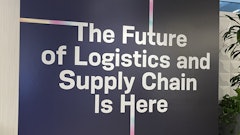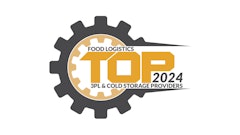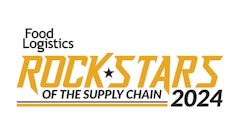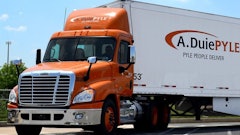
1. Dean Foods streamlines transportation operations - Hayword, CA - A leading dairy company in the U.S. and a global leader in soy products.
About two years ago, Dallas-based Dean Foods sought a technological solution to help streamline its transportation operation that includes extensive freight flows of dairy ingredients, dry van shipments and food-grade tankers. The company approached Dairy.com, a provider of supply chain solutions to the dairy industry with cost-effective, online applications that address the dairy industry’s highest spend categories: bulk commodities and transportation.
Dean Foods worked with Dairy.com to find solutions to its four major objectives: to minimize transportation costs while maintaining current levels of service; to rationalize and minimize fuel surcharges; to improve the efficiencies and transparency of its freight management processes for spot and contract freight; and to reduce embedded transportation costs for ingredients purchased on a delivered basis.
With Dean Foods’ input, Dairy.com developed an approach to revitalize transportation procurement and management processes, reports Bruce Matson, director of dairy procurement for Dean Foods. This approach included utilizing Dairy.com’s large membership of food-grade tanker carriers, re-bidding freight lanes strategically and leveraging advanced Internet-based supply chain management technologies.
To achieve competitive bidding of its freight lanes, Dean Foods used Dairy.com’s Strategic Transportation Service. This required that the two companies complete a review of Dean Foods’ current freight lanes, contracts and fuel surcharges. Then, utilizing Dairy.com’s database of historical freight costs, the two developed a prioritized set of opportunities from which they developed a multi-wave re-bidding plan encompassing over 1,000 freight lanes across Dean Foods’ 108 plants.
Once Dairy.com completes bid packages, it sends them to its carrier membership, including about 250 food-grade tanker haulers and dry van carriers. Dean Foods then receives from Dairy.com compiled bid responses and recommendations for action. The two companies collaborate on final carrier negotiations and Dean Foods makes the award decisions.
At this point, Dairy.com’s online collaborative scheduling application takes over the process, setting up the resulting freight contacts. Using this application, Dean Foods is able to make decisions concerning where to move product each week, reflecting these moves in its schedule. The solution automatically identifies the contract hauler or haulers for each lane, instantly tendering loads to haulers via email. Haulers then accept their loads online and Dean Foods’ schedule is instantly updated. This process reduces time associated with freight scheduling. If schedule changes need to be made by any party, the scheduler, the sell plant, the buy plant, and the carrier are all notified and updated automatically.
To expedite remaining non-contract moves, Dean Foods chose to leverage Dairy.com’s spot transportation exchange where shippers and haulers can post their needs and availability. Using this application, Dean Foods can flip loads from its schedule to the spot transportation exchange, which instantly notifies Dairy.com’s full hauler community via email and the Internet. Haulers then bid in real-time and Dean Foods receives the bids instantly, accepting the bids or negotiating further, all via the Internet. This central exchange helps both parties in establishing a fair market price. The exchange operates in real-time so traders can find the best deals within the time constraints of these short-shelf-life commodities.
For ingredients purchased on a delivered basis, Dean Foods directed Dairy.com to work with its suppliers to determine the freight cost component within its purchases. Dairy.com competitively bids these lanes to its hauler base to drive down costs.
To rationalize and minimize fuel surcharges, Dairy.com recommended that Dean Foods implement a standard fuel surcharge program. This program increased the efficiency of the bidding process for all parties involved. Dean Foods’ carriers were given the choice to accept the Dairy.com fuel surcharge structure—or to bid the business with no fuel surcharge using a flat rate. So far, this system is working favorably for Dean Foods.
The results of using the online solutions and services provided by Dairy.com have been exceptional with double-digit savings in several areas, reports Matson. For instance, Dean Foods has achieved about a 20-percent reduction in contract freight rates and between 20 percent and 40 percent savings in spot transportation costs. The elimination of embedded freight costs from purchased ingredients has saved the company about 30 percent of its transportation costs. Optimal scheduling produced about a 13-percent reduction in average miles per move, resulting in additional savings for the company.
“The visibility through the Dairy.com network allows for more consistency than we ever had working with our contract haulers for outbounds,” says Matson. “The system really helps us know who the carrier is that is hauling. We have a lot more consistency since the lanes are covered by the same carrier over and over again so the carriers become very familiar with the lanes we run. And since we are dealing only with one vendor in a particular plant, we have a lot less billing and accounts payable activities than we had with multiple carriers serving a particular plant.”
The more competitive rates Dean Foods is getting through Dairy.com’s bid list are another advantage, notes Matson. He adds that the alliance with Dairy.com also expedites the company’s drop-trailer activities.
“It’s been a win-win-win situation for Dean Foods, for the carriers, and for Dairy.com.,” says Matson. —April Terreri
2. Greatwide Logistics centralizes dispatch capabilities - DALLAS - A national provider of third-party logistics services.
Greatwide Logistics Services in Dallas wanted to increase efficiencies in its dispatching process, says Lloyd Boyd, CIO. “We meet high-service demands with a dedicated brokerage and managed transportation services type of model for the food segment of our business. The goal for us was to centralize our dispatch capabilities and standardize the process so we could create more efficiency and continue to create value for our customers by providing the service they expect at the price they expect,” explains Boyd.
Greatwide is the largest dedicated refrigerated provider in the country.
As the company sought to answer this question, it actually created another question. That was how to retain driver relationships with centralized dispatchers. Drivers are accustomed to being able to sit and converse with someone at a local operations center,” says Boyd. “They are on the road for long periods and they like to have that human interaction. So our question was how can we continue to provide that kind of personal attention.”
The solution for Greatwide was Microsoft’s XRM (Extended Relationship Management) product coupled with McLeod software used in the company’s centralized dispatch organization, Transportation Operations Center (TOC), at Greatwide headquarters.
“We slightly modified the XRM system to sit atop the McLeod trucking system. This provides an interface into the McLeod system that leverages some of the details we require for the relationship management,” Boyd explains. “The software helps us collect information that allows us to understand the haul preferences drivers have. We usually present drivers with a choice of loads based on their preferences and ask which one they prefer.”
Once the driver has selected his preferred load, dispatch selects the load and the system automatically updates which load was chosen and operations can then track the progress of that load through settlement and billing. Boyd notes this system first rolled out in December of 2009 and continues to be rolled out throughout Greatwide’s network of 59 operations centers.
How is the system working so far? “We were blown away by the results, which we measured,” reports Boyd. He says the company conducted two separate studies. One was a time-motion study clocking the entry time required to complete a dispatch going directly through the McLeod system. The company then studied the number of loads that were being managed by TOC before the rollout and the number of loads being managed after the rollout.
“Just considering the time-motion study, we measured a 500-plus-percent improvement. But it’s not just about how quickly you can enter data—we also have to consider the driver interaction and we want to account for that in our measurement. When we did consider this, we found there was a 263-percent improvement in productivity.”
Another amazing element of the system is its simplicity, Boyd reports. “We wanted the interface to be a simple point-and-click operation. This will help training labor for peak periods. This was another surprise for us because it used to require two days of training, but now it takes only two hours to train someone.” He adds that dispatchers confirm the system is easy to use and allows them to focus on making sure the load is executed properly without having to pay too much attention to the technology involved.
Another area providing cost benefit is having a solution to the cost of running empty miles. “Companies everywhere are trying to reduce their overall operating costs during this economic downturn,” explains Boyd.
The solution has exceeded Greatwide’s expectations, Boyd says. “It’s been a huge success with our business partners internally and with our operations group and our sales group. And it assures our customers that they will continue to receive the service they expect without interruption—even during peak periods.”
3. Cheney Bros. goes paperless, saves fuel with fleet solution - RIVERIA BEACH, FL - One of the largest foodservice distributors in the southern U.S.
Cheney Bros. Inc. is reducing operating costs by hundreds of thousands of dollars a year using a solution from Cadec Global, Manchester, NH.
Cheney Bros., Riveria Beach, FL, is one of the largest foodservice distributors in the Southern U.S. The company carries more than 15,000 national brand products and its annual revenues exceed $700 million.
In 2007, Cheney decided to upgrade from a first-generation fleet management product to a more advanced solution that would enable the company to remove all paper use from its transportation and delivery processes.
After an extensive search, Cheney selected Cadec Global’s Mobius TTS, an advanced fleet management system that enables companies to reduce costs, enhance customer service, enforce compliance and safety regulations and improve driver productivity.
With Mobius TTS, Cheney is now able to automatically collect, track and improve key efficiency and safety metrics and post reports in its transportation office for everyone to see. Company CIO Joe Haber reports that since Cheney Bros. implemented Mobius TTS:
• Excessive idle time has been eliminated;
• Fuel economy as measured in miles per gallon (MPG) is up; and
• Speeding, hard decels, unknown stops and accidents have been significantly reduced.
“Cadec is helping us fulfill our vision of removing all paper from the transportation and delivery process,” says Haber.
“In addition, when you consider all the savings enabled by our Cadec system—paper, fuel, labor and insurance—we estimate that we’ve reduced our operating costs by hundreds of thousands of dollars per year. That’s had a significant impact on Cheney Bros. bottom line,” he adds.
Cadec has 175 drivers at its Riveria Beach DC and 150 drivers in Ocola, FL.
4. TopSource LLC performs strategic sourcing for its members - BRAINTREE, MA - Helps retailers and wholesalers lower costs, improve profits.
TopSource LLC, a not-for-resale (NFR) division of Topco Associates LLC, is using innovative technologies and processes to help its members to lower costs and improve the efficiency of their supply chains.
Topco, based in Skokie, IL, is a private label purchasing consortium serving food retailers and wholesalers. TopSource’s main purpose is to help companies lower costs on a wide range of goods and services, including corporate and national brands, perishables, equipment, supplies and business services.
“Rising costs for ingredients and transportation as well as cutbacks in consumer spending have combined to create one of the most difficult environments for food retailers and wholesalers in recent history,” says Chuck Wright, director, sourcing, at TopSource, Braintree, MA. “We perform the strategic sourcing function for our members—smaller companies that compete with WalMart and Kroger. “
NRF spend is an area of huge savings potential for retail and wholesale companies. It’s spending on all products and services not resold to customers. According to TopSource, NFR spend represents one of the three largest categories of spend, along with cost of goods and wages. TopSource says it has saved customers an average of 18 percent in this area.
In order to achieve these results, TopSource is using a combination of Ariba Sourcing On-Demand, Ariba Contract Management and Ariba Supplier Performance Management. Ariba Sourcing was developed to enhance the ability to negotiate for goods and services and drive bottom-line savings.
Leveraging Ariba Contract Management, TopSource can manage and drive compliance with agreements. And through Ariba Supplier Performance Management, TopSource can discover, assess and on-board new supplier partners, with the ability to continuously measure and improve supplier performance.
“We chose Ariba because it offers a complete strategic sourcing solution,” says Wright. “So RFP, auction, contract and supplier management—we found the functionality of the tool to be superior to other solutions in the marketplace. Also, the of use for suppliers that participate in the events with us.”
TopSource’s eAuction offering can optimize capacity, quality service and cost for retailers that manage a diverse cross section of transportation, including dry and refrigerated transportation. By utilizing auctions, a TopSource customer has received up to 16 percent savings from high quality, fully qualified suppliers, while at the same time benefiting from a significant reduction in negotiation cycle time.
5. The Gillette Group minds its SKUs with business intelligence - LACROSSE, WI - Tenth largest Pepsi-Cola distributor in the country.
The Gillette Group, LaCrosse, WI, had to deal with some uncomfortable pain points when it came time to read and interpret weekly and monthly reports. That was before the company began using Salient Corp.’s Margin Minder Series business intelligence solution. Gillette Group is the tenth largest Pepsi-Cola distributor in the country, servicing a population of about 1 million people in the Midwest.
The company desired more visibility that would allow it to see where it was making a profit and where it was investing. But the paper reports it generated were not well received by Gillette employees. Typically, just the accounting department used the reports because they were familiar with the technology of reporting systems.
“But most employees never referred to the reports because they were not intuitive and they were too lengthy to read,” notes Patti Gillette-Ostrom, IT director. “It was painful for everyone involved, and especially painful for IT, as we had to create and distribute lengthy printouts and we often had to do follow-up reports which meant rewriting information.”
Over the last 10 years, the company’s business model changed from offering 128 SKUs to offering 500 SKUs to keep pace with competitors like Starbucks, Dole and Lipton Teas who were offering a variety of drinks including waters and flavored waters.
“Margin Minder helped us manage all of these SKUs,” reports Gillette-Ostrom. “Without Margin Minder, we would have needed a larger IT staff to write specialty reporting and we certainly wouldn’t have been able to get information instantaneously like we can now.”
A year ago, Gillette also deployed the Enterprise Version of Margin Minder so that it could achieve consistency and visibility in all four of its divisions. “We can access any level of depth of information now,” says Gillette-Ostrom. The company has at its fingertips detailed information regarding product delivery. Now it knows who the delivery is for, who the driver is, what the actual delivery route is and the day the order is delivered. Gillette also knows whether the order was assigned to be delivered on the day it was delivered—or if the order did not arrive when it should have.
The system provides information relative to which customers have had returns due to dated product, improper rotation or overstocking. With this amount of actionable information, Gillette easily can make any necessary adjustments and improvements in its routes.
User-friendly Margin Minder also enables Gillette to better understand who its top customers are. The system can also identify trends so Gillette can eliminate poor-performing products and aggressively market the successful ones.
Margin Minder’s benefits extend to the finance department as well, delivering information within minutes that used to take up to nine days to retrieve.
Gillette has improved the management of its vending business and assets using the system’s tracking capabilities.
Margin Minder helps Gillette make good business decisions, giving decision-makers the information they need to support their business strategies. “It helps us to have data that backs up what we want to do and why we want to do something; it also reinforces the reasons behind the business decisions we make,” Gillette-Ostrom says.
6. Just Born makes the ‘confection connection’ -
BETHLEHEM, PA - Markets its candy in over 45 countries.
Just Born Inc., the maker of Peeps, Hot Tamales, Mike and Ike and other iconic candy brands, had several logistics and environmental goals. The Bethlehem, PA-based company wanted to better satisfy its customers, control its long-term logistics costs, improve the overall sustainability of its supply chain, support the local economy and significantly reduce its carbon footprint.
To help achieve these goals, Just Born purchased a vacant distribution center within close proximity of its production facilities in Philadelphia and renovated it into a “class A” FDA certified, food grade facility. The move improved efficiencies for customers (fewer deliveries), and eliminated more than 500,000 truck-miles per year from Pennsylvania roads.
The retro-fit plan was designed with a goal of achieving a Silver Leadership in Environmental and Energy Design (LEED) certification. Broadening its original goals, Just Born is working with OHL to create a multi-vendor consolidation program. This will reduce costs for manufacturers that participate with Just Born in the program, and will lessen the environmental impact even more significantly.
By making the move, Just Born stands to improve its value-added services and distribution network, reduce cost, and improve sustainability. The company will also gain access to tier-one transportation and warehouse management systems by partnering with OHL to operate and manage the facility as its primary 3PL.
OHL, based in Brentwood, TN, manages over 32 million square feet of warehouse space primarily in North America. OHL will lease one-half of the Just Born distribution center and market the space to other manufacturers. Just Born and OHL will work together to build a larger and more efficient transportation coalition with the various manufacturers considering co-locating or using the facility as a regional cross dock for Mid-Atlantic and New England customers.
As a result of the Confection Connection project, Just Born had the opportunity to redesign and improve its logistics processes and systems from the bottom up, resulting in cost savings and the ability to get product to customers more quickly. In addition, one half million annual truck miles were eliminated from Pennsylvania roads and more than 70 jobs were created.
7. Sobeys Inc. automates picking in state-of-the-art DC - VAUGHAN, ONTARIO - Canada’s second largest supermarket operator.
If you ever wondered what distribution centers will look like in the future, take a look at Sobeys’ new state-of-the-art automated distribution center in Vaughan, Ontario, with its array of cranes, conveyor belts, cameras and sensors. The DC incorporates an automated picking and assembly system for improved product selection accuracy, optimal individual store order assembly, and improved delivery to Sobeys Ontario retail store network.
Sobeys made the decision to build the Vaughan DC because the company had been spending a significant amount of time manually handling order fulfillment, which drove up costs, damages and errors. The company’s workforce was spending a lot of time unloading pallets transferring product to carts, and then driving the carts to aisles for product replenishment to the shelves. Sobeys sought a leaner solution and found it at Witron Integrated Logistics, Arlington Heights, IL.
Witron’s logistics analysis recommended case-handling automation to address Sobeys’ goal of reducing handling costs, damages and error counts. Automation enables building a denser and taller order pallet with cases sequenced on pallets based on how they will be unloaded and replenished to the shelf. The majority of case picking is completely automated using Witron’s proprietary OPM (Order Picking Machinery) picking technology.
The OPM system automatically receives, stages, picks cases and builds mixed SKU pallets in a store-friendly and aisle-ready fashion. Products are stretch-wrapped and handed off to the shipping dock for loading onto trailers. The facility has 30 receiving bays and 41 shipping bays and is the largest warehouse in the Sobeys Inc. distribution network.
The new facility can handle 320,000 cases every day and offers three times the capacity of a conventional grocery distribution center. It is capable of shipping 200,000 cases daily. The DC operates 20 hours a day, seven days a week and operates with just 140 people—less than one-third of a workforce required of a conventional warehouse.
The facility, a half-million square feet of space, supplies to the Sobeys network of about 350 retail grocers, including Sobeys, Foodland, IGA and Price Chopper. Sobeys Inc., with headquarters in Stellarton, Nova Scotia, is Canada’s second-largest supermarket operator.
So far, the results have been impressive just a year shy of the facility’s first anniversary this July. Case-handling costs decreased by over 50 percent, and order accuracy rates nearly 100 percent. Damages have decreased, transportation savings have increased, and the cycle time to process an order has shortened significantly.
This major investment reflects Sobeys’ commitment to invest and innovate intelligently, providing optimal store and customer service at the lowest possible cost, notes Bill McEwan, president and CEO, Sobeys Inc. He adds that the greater benefit will be realized by customers at store level, as previously less-productive employee time is redeployed to further improve the quality and consistency of in-store service.
8. U.S. FoodService serves it up in the big apple - PERTH AMBOY, NJ - Second largest foodservice distributor.
Not many businesses would consider building a state-of-the-art facility during an economic downturn—especially in the Northeast, where new construction has ground down to a halt. But then again, U.S. Foodservice (USF)—the nation’s second largest broad line foodservice distributor—is not your ordinary company.
Its Metro New York division serves more than 3,000 customers in New York City and surrounding areas, selling to restaurants, schools, hospitals and chain restaurants—and counts some well-known establishments such as Madison Square Garden and the Hard Rock Café among its clients. With business booming, the company had outgrown its 156,000-square-foot distribution center in Edison, NJ, and decided to construct a larger facility, which it opened in January 2009.
Less than an hour’s drive from mid-town Manhattan, the new facility is located on a 65-acre track in Perth Amboy, NJ. At 615,000 square feet, the warehouse, which was designed and constructed by Hartland, WI-based design-builder ESI Group USA, is one of the largest food distribution centers in the Northeast.
The eco-friendly DC features high efficiency lighting solutions, refrigeration systems and a world class culinary innovation center.
“We selected this site because of the proximity to New York City—we’re able to service our customers from within the perimeter of the market,” says Chuck Gannon, president, USF Metro-New York.
With the opening of the DC, U.S. Foodservice-Metro New York has been able to strategically re-align the tri-state service area to improve responsiveness to its customer base while significantly reducing its carbon footprint.
The facility features a number of innovations, including its refrigeration system, which uses a mobile (skid-mounted) system that incorporates a two refrigerant (cascade) system utilizing R-22 and CO2 refrigerants. It uses refrigeration penthouse units (separate enclosures roof-mounted) in all refrigerated areas, which enables better performance and ease for maintenance.
The penthouses lift the units out of the warehouse, so they’re not taking out pallet positions, and when maintenance is called for, the units can be accessed from the roof.
In addition, the cascade system eliminates the OSHA PSM (Process Safety Management) requirements of ammonia refrigerant while still maintaining efficiencies.
“The system is much safer than ammonia and yet has tremendous capacity,” says Gannon. “We’re refrigerating north of 200,000 square feet today, with the capacity to refrigerate more space if needed.”
USF’s commitment is to be “your partner behind the plate” and the company certainly lives up to its motto. “USF decided at the start of this recession that the best strategy for our customers and associates would be to invest in the long-term success of our Perth Amboy, NJ, operations,” says Gannon. “with this strategy, we’ve been able to invest in and grow our workforce, and also provide our customers with quality products and valuable services that are important to winning in a challenging economy.”
9.CaseStack sees opportunity for growth in the economic storm - SANTA MONICA, CA - A provider of outsourced logistics services.
CaseStack, a third-party logistics provider based in Santa Monica, CA, wanted to narrow the gap in logistics services and costs between small and mid-level companies and their larger competitor-suppliers.
“As the economy struggles to emerge from the recession, the greatest challenge is for businesses to see this as an opportunity for market share growth rather than a storm they need to weather,” says Dan Sanker, the company’s president and CEO.
Sanker advises his own company and clients to take advantage of the downturn by refocusing investments on practices that best serve their customer base and ensure that the core competencies of the business are achieved.
For CaseStack, this requires an emphasis on maintaining a dependable supply chain and ensuring that customers overcome the challenges of maintaining inventory and distribution levels in the face of reduced economic resources. With this in mind, Sanker sets two core objectives for CaseStack and its customers: reduce the impact on the environment and increase supply chain efficiency.
To achieve these two traditionally unrelated goals, CaseStack set to redefine the conventional approach to sustainability. By focusing on growing and promoting less-than-truckload (LTL) and retailer consolidation programs, CaseStack is able to streamline customers’ ordering and tracking process and develop strategic partnerships with key members of the supply chain.
Built on an inherently sustainable model, CaseStack’s consolidation programs connect suppliers, retailers and carriers and increase efficiency through each step of the supply chain. This collaborative model enables suppliers to realize full truckload pricing by combining their LTL orders with those of other suppliers destined for the same distribution center, thereby reducing the number of trucks on the roads while garnering truckload pricing and improving efficiency for customers.
Diverging from common conceptions of “green,” CaseStack’s approach connects sustainability to efficiency and cost savings, transforming it into a profitable goal for suppliers and retailers alike. As a result, CaseStack customers realize increased efficiency and lower operating costs, enabling customers to invest in growing their business, rather than simply weathering the economic storm.
CaseStack’s One and Five Warehouse Consolidation programs enable clients to dovetail their commitment to improving efficiency and reducing environmental impact into one cost-saving logistics infrastructure. Leveraging strategic retailer and carrier partnerships, CaseStack fulfills “master” retailer purchase orders, consolidating multiple less-than-truckload shipments on one full truck. CaseStack’s customers benefit from full truckload pricing for LTL volume, while retailers enjoy greater order flexibility. Both benefit from a streamlined supply chain and a strengthened relationship.
CaseStack customers routinely experience 20 percent to 60 percent reduced transportation costs, a 98 percent on-time rate, reduced overstocks and out-of-stocks, a 50 percent reduction in damages and contribute significantly reduced carbon emissions. With suppliers enjoying decreased dock congestion, lower out-of-stocks and smaller inventory levels, the benefits are two-fold.
10. Kraft Foods Inc. eliminates thousands of empty miles - NORTHFIELD, IL - The world’s second largest food company.
Always keeping a strategic eye on its supply chain and transportation network, Kraft Foods Inc. wanted to eliminate waste in its overall network—including its supply chain partners—by reducing transportation costs and improving service levels and utilizing fleet assets where appropriate and beneficial.
The company turned to Chainalytics LLC, an Atlanta-based supply chain consulting firm, to help improve its transportation strategy.
“We hired Chainalytics first to do a consulting project to evaluate the right mix of private/dedicated/common carriers. After that project we partnered with them to do network overlays,” says Mike Cole, Kraft’s director of North American transportation.
Chainalytics offers proprietary tools and transportation cost data analysis to help companies optimize their transportation network while reducing costs and improving service levels.
The approach entailed collecting data from Kraft and three of its partners, which included CPG companies and retailers, to identify lanes where transportation collaboration would be cost beneficial. Reverse shipping lanes of sufficient volume were identified that met certain criteria, including:
• A minimal length of haul;
• The deadhead distance between the end points of the lanes had to be relatively short;
• The equipment requirements of the lanes had to be similar; and
• The cost of combining lanes into a round trip needed to be compelling.
Once a report of all of the candidates’ lanes and savings potential were created, Kraft met with its partners and discussed all operational concerns in moving the lanes to a collaborative process. At one point, the process for tracking and calculating savings was determined and the plan for implementation was outlined in detail.
The biggest obstacle for some of the trading partners, says Cole, was providing data in a useable format for Chainalytics to work with. “We asked our partners for the information and signed NDA (non-disclosure agreements).”
So far, Kraft has eliminated thousands of empty miles from its transportation network, with an anticipated cost savings to Kraft and its partners in excess of $3 million. “The next steps are continued collaboration with existing partners and selecting new partners to work with as we move forward,” says Cole.



























